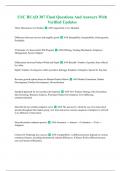USC BUAD 307 Final Questions And Answers With
Verified Updates
Three Dimensions of a Product ANS Augmented, Core, Branded
Difference between services and tangible goods ANS Intangibility, Inseparability, Heterogeneity,
Perishable
4 Elements of a Successful CSM Program ANS Offering, Funding Mechanism, Employee
Management, System Support
Differentiate between Product Width and Depth ANS Breadth: Number of product lines offered
by a firm
Depth: Number of categories within a product, Kelloggs breakfast: Nutrigrain, Special K, Pop tarts
Revenue growth options based on Market-Product Matrix ANS Market Penetration, Market
Development, Product Development, Diversification
Standard approach for new product development ANS New Product Strategy, Idea Generation,
Idea Screening, Business Analysis, Prototype Product Development, Test Marketing,
commercialization
Describe the new product adoption curve ANS The process by which the use of an innovation
spreads throughout the market group, over time and across various categories of adopters is referred
to as diffusion of innovation.
Describe product adoption process ANS Awareness → Interest → Evaluation → Trial →
Adoption
Criteria for Predicting new success ANS Compatibility- A diffusion process depends on various
consumer features, including international cultural differences. (Chinese firefox different because
user surf internet differently)
,-Observability: When products are easily observed, their benefits or uses are easily communicated to
others, so diffusion happens faster. (Lots of Prius commercials and people saw them on the road, so
they wanted to try them out; Botox not diffused fast because people don't want to talk about it).
-Complexity and Trialability: Products that are relatively less complex are also relatively easier to try.
These will diffuse faster. (Simply Apple, easier, than new speaker set to accompany tv brand)
Name Product Life Cycle stages ANS Introduction, Growth stage, maturity stage, decline stage
Difference between a brand and brand equity ANS 1. Brand: A name shape symbol and/or design
that communicates a product's attributes, benefits, values, and personality
2. Brand Equity: The set of assets and liabilities linked to a brand that add to or subtract from the
value provided by the product or service
Distinguish between manufacturer brands and private label ANS 1. Manufacturer's brands:
Brands owned and managed by the manufacturer, i.e. Coca Cola
2. Private Label Brands: Brands developed and marketed by a retailer and available only from that
retailer Costs of developing and marketing a manufacturer's brand are prohibitive
Challenges faced by Manufacturer brands? ANS 1. Some manufacturers prefer to make only
private-label merchandise because the costs of developing and marketing a manufacturer's brand are
prohibitive
2. Accessibility to audience via ads. Demographics harder to reach in large now, more effort required
3. Other firms manufacturer both their own national brand and merchandise for other brands or
retailers
Difference between line extension and brand extension ANS 1. Line Extension (vertical): The use
of the same brand name within the same product line and represents an increase in a product line's
depth -different types of toothpaste
2. Brand/Category Extension (horizontal): The use of the same brand name for new products being
introduced to the same or new markets - Colgate making toothpaste, toothbrushes, etc.
, Extension benefits ANS 1. New revenue sources
2. Reduced costs and risks for product introductions
3. Satisfy consumers desire for something different, and block competitors
4. Move customers to higher price points
5. Means for introducing technological innovations
6. Help control shelf space
7. Can satisfy retailers needs for slightly different versions
8. Can energize a brand
Extension problems ANS 1. Product is reduntant within line
2. Undermine brand loyalty
3. Under-exploited ideas
4. Poorer trade relations
5. Increased administrative costs
6. Too many choices confuse customers
Avoiding problems with extensions ANS 1. Stay consistent with brand's image
2. Improve cost accounting
3. Allocate resources to products that best support brand's future
4. Research consumer logic
5. Test your line logic
6. Customize marketing mixes
7. Expect and encourage product line turnover
8. Ensure channel partners are satisfied
Different benefits offered by packaging ANS Communication benefits, perceptual benefits,
functional benefits, environmental
Pros & Cons of Short Channel & Long Channel ANS Short Channel




